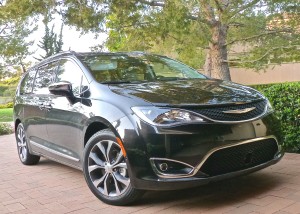Pacifica Blends Assets of Minivan and SUV
Filed under: Equinox, Autos
By John Gilbert
LAGUNA BEACH, Ca.—What would happen, I hear you ask, if all the slick new styling, interior features and attractions of SUVs and CUVs were combined with the family-friendly spaciousness and efficiency of a contemporary minivan, in one all-new vehicle? The result would be the 2017 Chrysler Pacifica — a brilliantly designed and finished family transportation module that could recapture the popularity once enjoyed by minivans.
A lot of the changes are subtle, and from a distance the Pacifica certainly looks like a minivan. But make no mistake: The Pacifica is entirely new, from its platform on up to its panoramic sunroof, and from its sleekly aerodynamic nose to its bob-tailed magnesium and aluminum liftgate. More than that, it drives brand new — more like a sports sedan than a soccer-mom-mobile, while pampering its occupants in quiet luxury.
The minivan as a U.S. automotive craze apparently ran its course in the three decades since.the sibling Dodge Caravan and Chrysler Town & Country created, expanded, and then dominated the segment that once sold about a million units per year. That number has dropped by about 50 percent as consumers become more and more infatuated with sports utility vehicles and now CUVs. But a half-million potential sales are still a lucrative target, and demographics indicating more kids are on the way might foretell a comeback for a vehicle that never really went away. Read more




 John Gilbert is a lifetime Minnesotan and career journalist, specializing in cars and sports during and since spending 30 years at the Minneapolis Tribune, now the Star Tribune. More recently, he has continued translating the high-tech world of autos and sharing his passionate insights as a freelance writer/photographer/broadcaster. A member of the prestigious North American Car and Truck of the Year jury since 1993. John can be heard Monday-Friday from 9-11am on 610 KDAL(www.kdal610.com) on the "John Gilbert Show," and writes a column in the Duluth Reader.
John Gilbert is a lifetime Minnesotan and career journalist, specializing in cars and sports during and since spending 30 years at the Minneapolis Tribune, now the Star Tribune. More recently, he has continued translating the high-tech world of autos and sharing his passionate insights as a freelance writer/photographer/broadcaster. A member of the prestigious North American Car and Truck of the Year jury since 1993. John can be heard Monday-Friday from 9-11am on 610 KDAL(www.kdal610.com) on the "John Gilbert Show," and writes a column in the Duluth Reader.